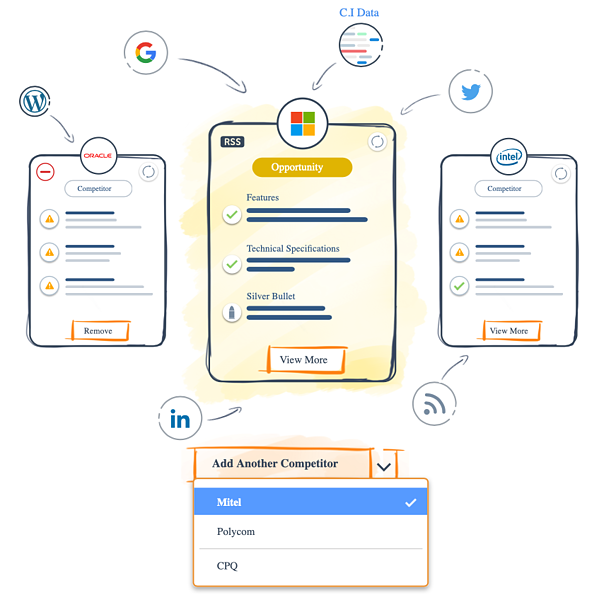How to Design and Measure Battle Cards that Work

Battle cards are one of those competitive intelligence tools that once you start using them, you won’t do without them again.
Key takeouts:
- Effective battle cards work for the right person at the right time.
- When designing a battle card system, you should always take a customer-centric approach so that every person involved in a sales deal has the information they need.
- And how will you know if it’s working? In short, your team will win more deals.
A battle card system that is designed correctly and continuously measured and optimised can and should be your secret weapon in any competitive sales situation.
Effective battle card design is all about finding the right battle card for the right person at the right time. With so many parts and parties in a sales deal; from internal and technical sales to account managers and customer support, a battle card has to be many things to many people to be both effective and customer-centric.
What is an ‘effective’ battle card?
Simply speaking, an effective battle card gives your sales team the numbers, information, and context to help your company win more deals. Building an in-house team or group of trusted advisors is critically important in the design and implementation of the information. These field champions team can ensure the creation of relevant and up-to-date battle cards, and help to build them into the workflow.
An efficient life cycle of creating a battle card can be broken down into three states: pre-design, in design, and post design. Each state begins and ends with customer experience, which drives design, format, form, and flow. A battle card has to satisfy certain criteria to be customer-centric, and meet the numerous needs across the sales team. And an effective battle card has gone through these processes and considered each of these factors.
A report by the International Data Corporation (IDC) stated that “sales team members don’t use as much as 80% of the content that marketing generates even though most of it is created for sales and channel enablement.” In other words, only 20% of the marketing content is effectively used, and any other information that a sales team needs has to be found by the team itself. This is the definition inefficient but can happen for a number of reasons. Sales teams might not be aware the information exists or is available, or might not have time to sort through the content. For this reason, it’s essential that battle cards reduce extraneous information.
What is a ‘customer-centric’ battle card?
There are a number of different parts to a sales team, and each needs a number of different information sets. Accountants, inside sales, customer support, and executives show up and want answers to a variety of questions about a competitor, and it’s essential for a sales team to have answers to those questions. Some people and teams think of battle cards as an entire competitive intelligence program, but this philosophy can limit the scope of what an effective competitive intelligence system can do.
While an effective battle card contains plenty of relevant information, it does not overload the user with information. How can you achieve this outcome of ‘just the right amount’ of information with limited resources (as is often the case)? Here are a few standard formats that can help you and your team:
- Cheat/hot sheet: 1 page
- Competitive battle card: multi-page, focused on single offer
- Competitive playbook: multi-page, focused on single company
- Competitive feature matrix: usually excel, with macros
- Sales guide: focus on your products, may contain competitor information
As with any system, there are pros and cons to each format. However, creating a system and establishing a direct path for your team will be immensely beneficial, and can also help make a small team feel like a big team. Investing in a system that can dynamically produce and scale these audience-centric battle cards is worth considering if your sales team is currently facing sticking points in competitive engagements. Systems like the CompeteIQ platform solve for this using artificial intelligence.
The process for creating and designing an audience-centric battle card includes thinking about how the audience consumes information, what their experience will be like, and what their specific needs are.
The next thing you’ll need to consider is measuring if what you have produced for your team is working.

The CompeteiQ Battle Card System
Measuring the effectiveness of battle cards
Do you have data that proves the usefulness of your battle card? If so, what is that data based on?
There are several factors of measurement that you might take into consideration when measuring the influence of your battle cards:
- The utilization of competitive intelligence
- The number of downloads your website might register
- Direct feedback from clients can turn subjective information into objective data that can be used to adjust current methods or strategies
- Decision-specific support based on consultations, narrowcasting, or active deal support can help show which account teams are competing with which competitors, thereby showing overall productivity
Something also worth considering is revenue attribution or association which typically requires the use of a CRM system like Salesforce, but not all the time. This means your data is mixed in with other teams’ data, potentially making it more comprehensive and thorough. By putting your data into a competitive intelligence dashboard, you position yourself to build better business processes that tie battle card content into sales opportunities. Your data becomes part of the team and its story, creating an association between sales battle cards, and success.
Throughout measurements of any kind, including battle cards, it is always important to make sure the data is clear and accurate, with little if any discrepancies or fuzzy guesses. Additionally, data should not be misrepresented or misinterpreted to your coworkers or teammates, and should certainly not be a last-minute surprise before a sales meeting.
Imagine you are able to ask sales operations to run a report that directly related battle card utilization to deals won vs deals lost. Knowing and trusting your measurements can be incredibly valuable and useful for determining the future approaches and goals of your sales team.
At the end of the day, a sale is a team effort. Each team member has to be able to rely upon and trust not only their teammates but the data and battle cards they use in their sales. In this way, measuring your battle cards can also be a way of measuring your team.
And once you’ve put every effort into ensuring that they are designed correctly and for the right audience, you can make your sales team’s work life easier and you competitive intelligence work consistently for you.

